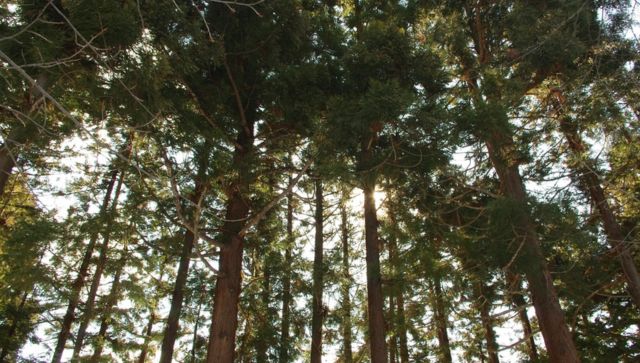Japan is planning to axe thousands of cedar trees in the coming years. The decision has been taken amid the Asian country’s battle with hay fever every year. In a ministerial meeting on Tuesday (30 May), the Japanese government unveiled measures aimed at tackling hay fever triggered by pollen from cedar and cypress trees. As per Japanese broadcaster NHK, Prime Minister Fumio Kishida said at the meeting: “Hay fever is a cause of suffering for many citizens and a social problem that has not been addressed effectively. It’s necessary to implement prompt action with an eye on the future.” What are the proposed measures and why do cedar trees have to be chopped? How hay fever affects the population in Japan every year? Let’s take a look. Proposed plan The Japanese government plans to reduce areas of artificially planted cedar trees by around 20 per cent over the next 10 years – from the current 50,000 hectares of the trees per year to 70,000, reported Kyodo news agency.
This will be done with the aim to slash the country’s pollen count by half in 30 years.
The government has decided to plant other species of trees or those varieties of cedar that shed less pollen in these cleared areas, as per the agency. The proposed plan also includes promoting the use of timber from domestic cedar trees by encouraging home builders. Another proposal is to employ supercomputers and artificial intelligence to improve pollen forecasts. Japan will also invest in medical care to prevent the onset of hay fever. In order to alleviate symptoms, the government will boost the production of immunotherapy drugs to cover up to 1 million people over five years from the current 250,000, reported Japan Times. These measures are expected to be included in a set of economic policies that will be adopted in June. Japan’s cedar trees Japan’s seasonal hay fever – which is estimated to affect 40 per cent of the population – is blamed on the country’s large number of cedar trees. As per the World Economic Forum report, nearly 70 per cent of hay fever cases are attributed to cedar pollen in Japan. [caption id=“attachment_12667602” align=“alignnone” width=“640”] Cedar trees cover 18 per cent of Japan’s forests. Wikimedia Commons File Photo[/caption] Cedar trees cover 18 per cent of the country’s forests, the report added. After the end of the Second World War, the East Asian nation planted trees at a rapid rate under the reforestation programme to bolster the construction industry, reported The Guardian. These trees start shedding pollen at the beginning of every year, prompting a bout of hay fever cases. ALSO READ:
Why the Japanese are taking lessons on how to smile Hay fever outbreak The symptoms of hay fever are similar to those of a cold such as a runny nose, itchy, watery eyes and sneezing. Some people can also suffer from shortness of breath and earache. If the pollen allergy symptoms are severe, it can also lead to loss of sleep and even affect work. According to a 2020 study conducted by Panasonic Holdings Corp, around 80 per cent of hay fever patients in Japan said that the allergy reduced their productivity. The company projected that hay fever causes an economic loss of 221.5 billion yen ($1.7 billion) per day because of reduced concentration and working ability in employees, as per Bloomberg. A survey carried out by a group of ear, nose and throat specialists found a steady surge in hay fever cases since the late 1990s, with 2019 seeing 42.5 per cent patients, an increase from 29.8 per cent in 2008 and 19.6 per cent in 1998, reported Kyodo News. In Japan’s capital Tokyo, pollen levels reached their highest in a decade in April this year.
Addressing a parliamentary committee at the time, Kishida had said that hay fever has become a “social problem”.
Some companies in the country have also offered “hay fever allowances” which workers can use on getting treatment. ALSO READ:
Allergic Rhinitis: A neglected disease sharing symptoms with COVID-19; here's how to identify it As The Guardian noted, the hay fever outbreak could be a reason why people in Japan are hesitant to shed masks in public despite the government having lifted the requirement to prevent COVID-19. [caption id=“attachment_12667632” align=“alignnone” width=“640”] Japanese wear masks in public to keep themselves safe from cedar pollen. Reuters File Photo[/caption] “The amount of pollen is so high this year that [mask-wearing] is unlikely to end for some time,” a spokesperson for Unicharm, Japan’s biggest manufacturer of disposable masks, earlier told the Yomiuri Shimbun. According to Japan Weather Association, the situation has been made worse owing to high temperatures than usual. On how to deal with hay fever, Yoko Tsukamoto, a professor of infection control at the Health Sciences University of Hokkaido, told South China Morning Post (SCMP), “Wear a covering over your nose and mouth and protect your eyes from the pollen spores with glasses. Anyone who suffers from hay fever should also avoid rubbing their eyes and wash their hands regularly.” “It is impossible to avoid pollen entirely, so the advice is to reduce the amount you breathe in to the minimum and to avoid accumulating pollen,” she added. With inputs from agencies Read all the
Latest News ,
Trending News ,
Cricket News ,
Bollywood News , India News and
Entertainment News here. Follow us on
Facebook,
Twitter and
Instagram.


)

)
)
)
)
)
)
)
)



